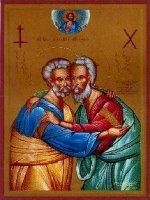 The Eastern Catholic Churches – A Help or a Hindrance to Christian Unity?, The Reverend A T J Salter. £3 including postage from the author, Chairman of the Society of St John Chrysostom, 1 St James Close, Bishop Street, London N1 8PH
The Eastern Catholic Churches – A Help or a Hindrance to Christian Unity?, The Reverend A T J Salter. £3 including postage from the author, Chairman of the Society of St John Chrysostom, 1 St James Close, Bishop Street, London N1 8PH
In this booklet, Fr. Salter gives an outline history of the Eastern Churches and their entry into union with the Holy See. He argues that “Uniatism” or Latinization of the ancient rites of the Eastern Churches should be avoided, as this is a hindrance to the witness of the so-called Uniate Churches.
The Latinization was the policy often pursued by the Latin Catholics in Poland, and also some Eastern Catholics were guilty of it. He reminds his readers that the largest union achieved between Rome and the Eastern Churches (the Ukrainian) in 1596 at Brest-Litovsk was ideally a union of faith and not of rite. Pope Clement VIII proclaimed the union in his bull Magnus Dominus et Laudibilis of 23rd December 1595. The Ukrainian Rite was to be preserved and this was reiterated by Pope Clement VIII`s successors. Pope Benedict XIV was adamant that there should be no ritual or ceremonial changes introduced into the Ukrainian/Ruthenian Rite by even the greatest prelates of the Eastern Catholic Churches, without first seeking and obtaining permission from the Apostolic See. This is proclaimed in the bull Demandatum Coelitis.
More widely the book explores how for the most part the Eastern Catholic Churches, far from forming part of a policy of proselytism by the Roman See among the Orthodox, are more truly descendants of previous attempts of genuine corporate reunion and re-established communion. Political and cultural factors, as well as religious and doctrinal, have stood in the way of efforts to overcome the effects of the Great Schism throughout the second millennium, but the soreness of the divide (as it became) in Ukraine was not the same experience in other parts of the world where there were Catholics and Orthodox of the Eastern Church living alongside each other. The positive contribution of the Armenian Catholics to Armenian Orthodoxy is a case in point, as was the pragmatic and positive relations among Catholics, Orthodox and Oriental Orthodox living under the Ottomans.
A low point in terms of the Eastern Catholic position vis a vis Orthodoxy may have been the First Vatican Council and its unfinished business of the declaration concerning Papal Infallibility – exemplified par excellence in the humiliation of the objecting but loyal Melkite Patriarch. But in the 20th century things have changed – Pope Paul and Patriarch Athenagoras lifted the 900-year old mutual excommunications, the Eastern Catholics at Vatican II (notably Archbishop Elias Zoghby) made a powerful case against Uniatism in tune with the fresh thinking of the Catholic Church as communion, not a mere juridical body, and increasing warm and imaginative relations and initiatives towards unity involving the Eastern Catholics with their Orthodox and “pre-Chalcedonian” Orthodox counterparts, particularly in areas where the Christian community as a whole faces a larger external challenge – the Middle East (eg the Balamand formula for communion among Greek Catholics and Greek Orthodox in the patriarchate of Antioch), Iraq (a new friendship between the Chaldean Catholic Church and the Assyrian Church of the East) and more recently in Ukraine, where Orthodox unity is under pressure and Ukrainian Catholicism, historically seen as a rival is becoming a valued ecumenical friend.
And Pope John Paul famously added impetus to the sense that the Catholic Church needs the Christian East – and unity with the Orthodox Church – as a priority, notably in his ground-breaking Letter on ‘The Light from the East’, Orientale Lumen in 1996, shortly followed by the Encyclical on Ecumenism, Ut Unum Sint, in which he called for Christians in other Churches to re-imagine the papacy, the Petrine Ministry, to propose how it could be of service in the reality of the Church today and a servant of the one Great Church’s unity and communion. And both Pope John Paul and Pope Benedict have stressed the theme of the Church needing both lungs to breathe on, and how what the Catholic Church wants is not jurisdiction but communion.
Could it be that the historic Eastern Catholic Churches, not well understood in the Latin West and at times greatly misunderstood in the East, in a new age, with new conditions, having confirmed their distinctive role and function, their integrity as Churches, and having been refined in the purifying fires of suffering and persecution alongside their Orthodox fellow Christians, can point a way towards restored communion with confidence? Certainly the friendships and theological awareness growing through the current Orthodox-Catholic dialogue suggests it may be possible on the official level, and the Orientale Lumen series of conference inspires a like aspiration.
